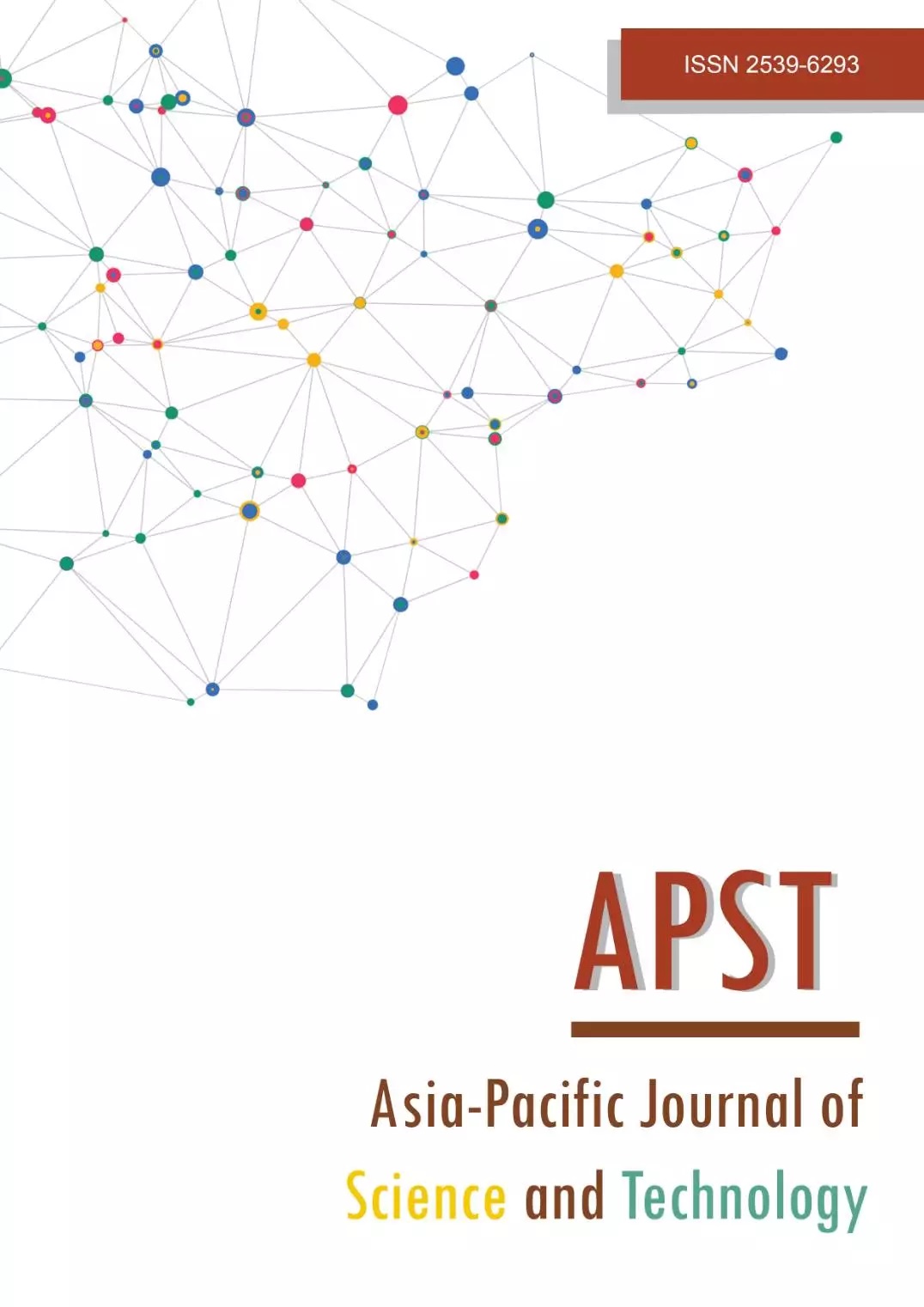Clustering optimisation using fuzzy c-means clustering and artificial bee colony algo-rithm for wireless sensor network
Main Article Content
Abstract
Wireless sensor networks (WSNs) play an important role in numerous applications such as industrial automation, commercial, robotics, environmental monitoring, landslide detection, earthquake detection, transport and logistics, and habitat monitoring. WSN clustering provides an efficient way to improve the network lifetime, throughput, scalability, and packet delivery ratio. However, the performance of WSN is limited because of low-power battery-operated sensor nodes and improper positioning of the cluster heads (CHs) during cluster formation. This study presents a fuzzy c-means algorithm (FCM) for WSN clustering and an artificial bee colony (ABC) algorithm for optimal selection of CHs. The proposed ABC considers various factors for clustering, such as the energy Gini coefficient, CH energy balancing, inter- and intra-cluster distance, and CH load balancing factors. The proposed algorithm provides optimised cluster selection that provides better network lifetime and throughput than traditional FCM.
Article Details

This work is licensed under a Creative Commons Attribution-NonCommercial-NoDerivatives 4.0 International License.
References
Kirubasri G. A contemporary survey on clustering techniques for wireless sensor networks. Turk J Comput Math Educ. 2021;12(11):5917-5927.
Kaur A, Gupta P, Garg R. Soft computing techniques for clustering in WSN. IOP Conf Ser: Mater Sci Eng. 2021;1022:012041.
Daanoune I, Abdennaceur B, Ballouk A. A comprehensive survey on LEACH-based clustering routing protocols in Wireless Sensor Networks. Adv Hoc Netw. 2021;114:102409.
Rawat P, Chauhan S. Clustering protocols in wireless sensor network: A survey, classification, issues, and future directions. Comput Sci Rev. 2021;40:100396.
Ramani KPL, Badholia A. Cluster based routing protocols In WSN Sensor. Information. Technol Inter-face Industry. 2021;9(1):198-206.
Rathore PS, Chatterjee JM, Kumar A, Sujatha R. Energy-efficient cluster head selection through relay approach for WSN. J Supercomput. 2021;77(7):7649-7675.
Mishra PK, Verma SK editors. A survey on clustering in wireless sensor network. 11th International Confer-ence on Computing, Communication and Networking Technologies (ICCCNT); 2020 July 1-3; Kharag-pur, India. Kharagpur: IEEE Publications; 2020. p. 1-5.
Raam KVJ, Rajkumar K. A Novel Approach using Parallel Ant Colony Optimization Algorithm for De-tecting Routing Path based on Cluster Head in Wireless Sensor Network. Indian J Sci Technol. 2015;8(16):1-7.
Liu X, Fu H. An effective clustering algorithm with ant Colony. J Comput. 2010;5(4):598-605.
Gupta V, Sharma SK. Cluster head selection using modified ACO. Proceedings of the fourth international conference on soft computing for problem solving. Adv Intell Syst Comput. 2015;335:11-20.
Aadil F, Bajwa KB, Khan S, Chaudary NM, Akram A. CACONET: Ant Colony Optimization (ACO) Based Clustering Algorithm for VANET. PLoS One. 2016;11(5):e0154080.
Yang J, Xu M, Zhao W, Xu B. A multipath routing protocol based on clustering and ant colony optimiza-tion for wireless sensor networks. Sensors (Basel). 2010;10(5):4521-4540.
Kalaimani D, Zah Z, Vashist S. Energy-efficient density-based Fuzzy C-means clustering in WSN for smart grids. Aust J Multidiscip Eng. 2021;17(1):23-38.
Dagur A, Malik N, Tyagi P, Verma R, Sharma R, Chaturvedi R. Energy enhancement of WSN using fuzzy C-means clustering algorithm. In: Jacob IJ, Shanmugam SK, Piramuthu S, Gilski PF, editors. Data Intelli-gence and Cognitive Informatics. Singapore: Springer. 2021. p. 315-323.
Karim SM, Ozturk C, Mahmood MK. ABC-based optimization of cluster head selection in wireless sensor networks. Int J Electr Eng Inform. 2021;13(2):287-296.
Almajidi AM, Pawar VP, Alammari A, Ali NS. ABC-based algorithm for clustering and validating WSNs. In: Gunjan VK, Suganthan PN, Haase J, Kumae A, Raman B, editers. Cybernetics, Cognition and Ma-chine Learning Applications. Singapore: Springer; 2020. p. 117-125.
Bhangale K, Mohanaprasad K. Speech emotion recognition using mel frequency log spectrogram and deep convolutional neural network. In: Sivasubramanian A, Shastry PN, Hong PC, editors. Futuristic Communication and Network Technologies. Singapore: Springer; 2022. p.241-250.
Bhangale KB, Mohanaprasad K. A review on speech processing using machine learning paradigm. Int J Speech Technol. 2021;24(2):367-388.
Bhangale KB, Kothandaraman M. Survey of deep learning paradigms for speech processing. Wireless Pers Commun. 2022;125(2):1913-1949.
Bhangale K, Ingle P, Kanase R, Desale D. Multi-view multi-pose robust face recognition based on VGG-Net. In: Chen JLZ, Tavares R.S, Lin Du K, IIiyasu AM, editors. Second International Conference on Im-age Processing and Capsule Networks. Cham: Springer; 2022. p.414-421.
Bhangale KB, Desai P, Banne S, Rajput U, editors. Neural Style Transfer: reliving art through Artificial Intelligence. 3rd International Conference for Emerging Technology (INCET). 2022 May 27-29; Belgaum, India. Belgaum: IEEE Publications; 2022.
Vijayalakshmi K, Anandan P. Global levy flight of cuckoo search with particle swarm optimization for effective cluster head selection in wireless sensor network. Intell Autom Soft Comput. 2020;26(2):303-311.
ShayestehTabatabaei S. A novel fault tolerance energy-aware clustering method via social spider optimi-zation (SSO) and fuzzy logic and mobile sink in wireless sensor networks (WSNs). Comput Syst Sci Eng. 2020;35(6):477-494.
Wang J, Han H, Li H, He S, Sharma PK, Chen L. Multiple strategies differential privacy on sparse tensor factorization for network traffic analysis in 5G. IEEE Trans Ind Inform. 2021;18(3):1939-1948.
Wang J, Gao Y, Zhou C, Simon Sherratt R, Wang L. Optimal coverage multi-path scheduling scheme with multiple mobile sinks for WSNs. Comput Mater Continua. 2020;62(2):695-711.


